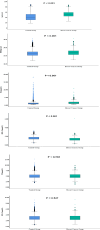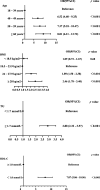A cross-sectional study of serum lipids, body mass index and age relationships with breast cancer risk
- PMID: 40287713
- PMCID: PMC12034170
- DOI: 10.1186/s12957-025-03817-y
A cross-sectional study of serum lipids, body mass index and age relationships with breast cancer risk
Abstract
Background: Globally, the most common malignancy in women today is breast cancer. Numerous factors affect the incidence of breast cancer; therefore, we examined the connections involving age, body mass index (BMI), serum lipid levels, and breast cancer risk in women.
Methods: This was a cross-sectional analytical study. 382 female patients with a breast cancer diagnosis in this study, and 11842 healthy, age-matched females who were selected from physical examination centers in the same period. Univariate analysis was conducted first, after which factors with statistically significant differences were used to construct a multi-factor binary logistic regression equation. We explored associations across different ages, BMI, triglyceride (TG), and high-density lipoprotein-cholesterol (HDL-C) levels, and breast cancer risk.
Results: Age, BMI, TG, and HDL-C were the risk factors that showed the most significant association with breast cancer. Age, BMI, low-density lipoprotein-cholesterol (LDL-C) and TG levels in the breast cancer group were higher than those in the control group, but HDL-C and total cholesterol (TC) levels were lower. As BMI and TG levels increased, the risk of developing breast cancer increased, and, as HDL-C levels decreased, the risk of developing breast cancer increased. Women aged ≥ 40 years old had an increased breast cancer risk. There were no significant variations in TC and LDL-C levels between groups.
Conclusions: In this study, a lower risk of breast cancer was linked to high HDL-C levels, while a higher risk of breast cancer was linked to high BMI and TG levels. Women aged ≥ 40 years old had an increased breast cancer risk.
Keywords: Age; Body mass index (BMI); Breast cancer; Serum lipids.
© 2025. The Author(s).
Conflict of interest statement
Declarations. Ethics approval and consent to participate: Ethical approval: This study was performed in line with the principles of the Declaration of Helsinki. Approval was granted by the Ethics Committee of the Fifth Affiliated Hospital, Southern Medical University (approval number: 2024-RXK-K-001). Consent for publication: Not applicable. Competing interests: The authors declare no competing interests.
Figures
Similar articles
-
Could Anthropometric and Lipid Parameters Reflect Susceptibility to Breast Cancer? Comparison of Newly Diagnosed Breast Cancer and Apparently Healthy Women.Asian Pac J Cancer Prev. 2018 Sep 26;19(9):2475-2480. doi: 10.22034/APJCP.2018.19.9.2475. Asian Pac J Cancer Prev. 2018. PMID: 30255702 Free PMC article.
-
Lipid Profile and Atherogenic Risk Assessment in Nigerian Breast Cancer Patients - A Cross-Sectional Study.J Am Nutr Assoc. 2024 Sep-Oct;43(7):582-591. doi: 10.1080/27697061.2024.2353289. Epub 2024 May 28. J Am Nutr Assoc. 2024. PMID: 38805002
-
[A case-control study on the association between serum lipid level and the risk of breast cancer].Zhonghua Yu Fang Yi Xue Za Zhi. 2016 Dec 6;50(12):1091-1095. doi: 10.3760/cma.j.issn.0253-9624.2016.12.013. Zhonghua Yu Fang Yi Xue Za Zhi. 2016. PMID: 28057114 Chinese.
-
Serum lipids and outcome of early-stage breast cancer: results of a prospective cohort study.Breast Cancer Res Treat. 2005 Nov;94(2):135-44. doi: 10.1007/s10549-005-6654-9. Breast Cancer Res Treat. 2005. PMID: 16261412
-
[Association of serum lipid profile with distant metastasis in breast cancer patients].Zhonghua Zhong Liu Za Zhi. 2012 Feb;34(2):129-31. doi: 10.3760/cma.j.issn.0253-3766.2012.02.010. Zhonghua Zhong Liu Za Zhi. 2012. PMID: 22780931 Chinese.
References
-
- Global cancer observatory: cancer today. International Agency for Research on Cancer. World Health Organization. 2024. https://gco.iarc.who.int/media/globocan/factsheets/populations/900-world.... Accessed 08 Feb 2024.
-
- Britt KL, Cuzick J, Phillips K-A. Key steps for effective breast cancer prevention. Nat Rev Cancer. 2020;20:417–36. - PubMed
MeSH terms
Substances
LinkOut - more resources
Full Text Sources
Medical
Research Materials
Miscellaneous



